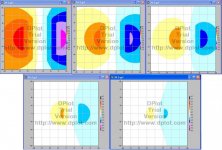Excellent post, Colin. Very well thought out, and very well stated.Good to see we're back on topic.
Not to be a nit-picker, because CJ's advice is very useful for most players in most situations where they are applying inside english. A few points to consider though:
This advice works well on soft to medium speed shots when the player is bridging shorter than the effective pivot point, which is predominant imho.
On firmer shots, the effective pivot point gets shorter, so pivoting may lead to over cutting in those situations. The reduced throw at CB - OB contact also thins the cut on firmer shots.
Also, for players who bridge beyond the length of their effective pivot point, pivoting will also over cut.
For many players, some degree of slight parallel aiming off center, followed by a little pivot, could be a predictable way for them to play inside english more confidently on soft to medium speed shots with less than 3 feet between CB and OB.
On longer and more powerful IE shots, I much prefer a pure pivot mechanism, but this relies on more familiarity with the effective pivot point for that cue, speed of shot and table conditions (which effect swerve).
If people want to learn more background dealing with some of these important topics, more info can be found here:
cue natural pivot length
squirt, swerve, and throw effects
back-hand english (BHE) and front-hand english (FHE)
inside english effects
Colin, it is good to have you back in full force on AZB. You have been missed. Where have you been?
Cheers,
Dave
